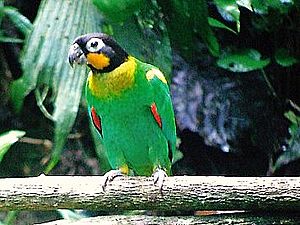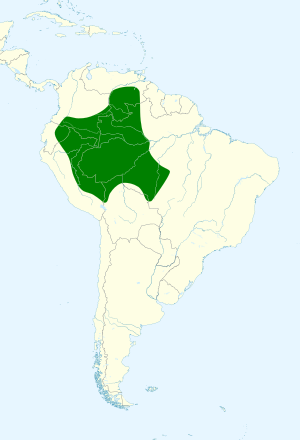Orange-cheeked parrot facts for kids
Quick facts for kids Orange-cheeked parrot |
|
|---|---|
 |
|
| Conservation status | |
| Scientific classification | |
| Genus: |
Pyrilia
|
| Species: |
barrabandi
|
 |
|
| Synonyms | |
|
Pionopsitta barrabandi |
|
The orange-cheeked parrot (Pyrilia barrabandi), also known as Barraband's parrot, is a colorful species of parrot. It belongs to the family called Psittacidae. These parrots live in the Amazon Basin in South America.
You can find them in humid lowland forests. They live in the northwestern, southwestern, and south-central parts of the Amazon. Sadly, their homes are shrinking because of increasing deforestation in the Amazon.
Contents
Naming and Types
This parrot's scientific name, barrabandi, honors a French artist named Jacques Barraband. The bird was once placed in a different group called Pionopsitta.
There are two main types, or subspecies, of the orange-cheeked parrot:
- P.b. barrabandi: This type lives north of the upper Amazon River. You can find them in parts of northern Brazil, southern Venezuela, southeast Colombia, eastern Ecuador, and northeastern Peru.
- P.b. aurantiigena: This type lives south of the upper Amazon River. They are found from northern Brazil to eastern Peru and northern Bolivia.
Appearance
Orange-cheeked parrots are about 25 cm (9.8 in) long. They usually weigh between 165–190 g (5.8–6.7 oz).
Adult Parrots
Adults have an olive-colored throat and chest. Their upper legs are yellow. The front part of their wings and the smaller feathers under their wings are yellow to orange. The very edge of their wings and the larger feathers under their wings are orange to red. The tips of their tail and wing feathers are blue.
The P.b. aurantiigena type has deep orange cheeks. Their wing bends, underwing feathers, and upper legs are also orange. They do not have the yellow colors seen in the barrabandi type. Both types have a black head and orange to yellow cheeks. They have a clear white ring around their brown eyes. Their beak is gray to black.
Young Parrots
Young parrots, called juveniles, look a bit different. They have a brown top of the head. Their forehead, back of the neck, cheeks, and chin are olive with brown edges. The bend of their wings and the smaller feathers under their wings are green with some yellow. The edge of their wings and the larger feathers under their wings are red with some green feathers mixed in.
Sounds They Make
These parrots make special calls when they fly. Their calls sound reedy and slurred. They also have loud, rough alarm calls if they sense danger.
Daily Life and Habits
Orange-cheeked parrots are most active in the early morning. You can often see them alone, in pairs, or in small groups of up to 10 birds. They sometimes gather at clay banks.
What They Eat
These parrots eat seeds and fruit. They also eat wasp larvae found inside plant growths called galls. They usually look for food high up in the trees. They also visit clay banks to eat soil. This soil acts like an antacid, helping to balance the acids in the food they eat.
Reproduction
Their breeding season is likely around September and October.
Where They Live
The orange-cheeked parrot lives in northwestern Brazil, western Ecuador and Peru, southern Venezuela and Colombia, and the very north of Bolivia. They are found in lowland forests up to 400 m (1,300 ft) high. They prefer "terra firme" forests, which are not flooded. They also live at the edges of forests and in forests that have been partly disturbed by humans.
Protecting Them
The orange-cheeked parrot is listed as "Least Concern" on the IUCN Red List. This means they are not currently in immediate danger of disappearing. However, they are sensitive to the increasing deforestation in the Amazon rainforest. Their population might decrease by 25-30% as they lose their homes. This species is naturally rare in the areas where it lives.
As Pets
These parrots are not commonly kept as pets. However, some people in Brazil do keep them.
See also
 In Spanish: Lorito carinaranja para niños
In Spanish: Lorito carinaranja para niños


